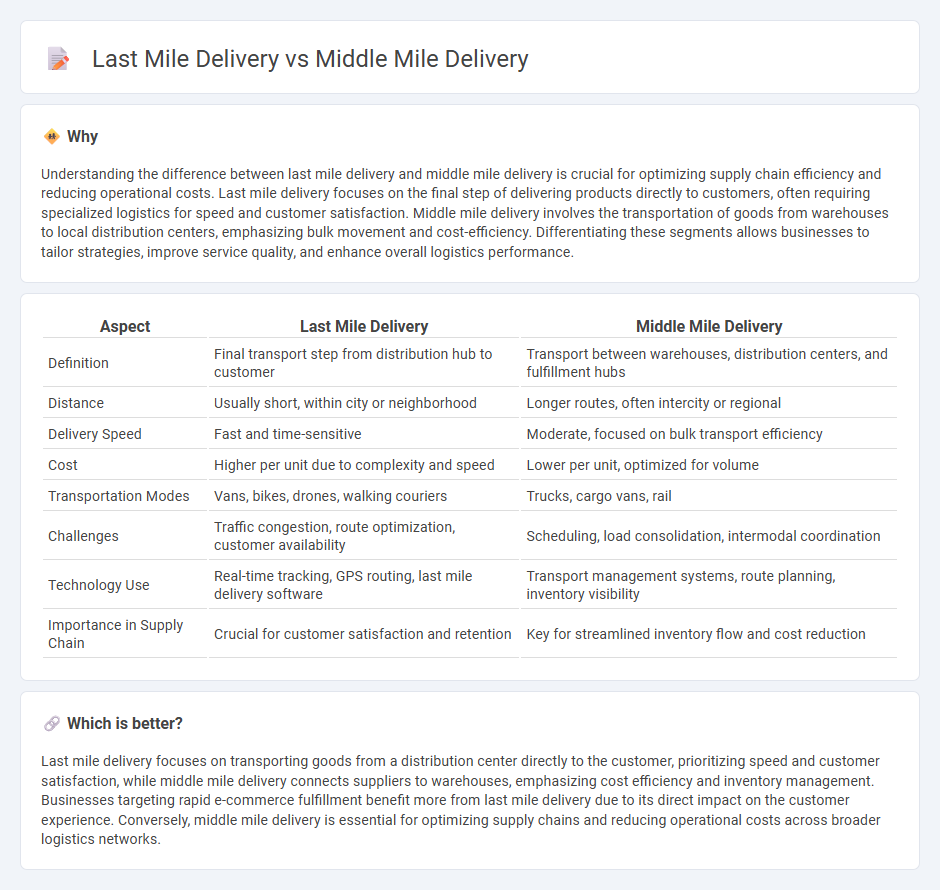
Last mile delivery focuses on transporting goods from local distribution centers directly to the end customer, ensuring speed and convenience, while middle mile delivery involves moving products between warehouses or from manufacturers to retail locations, emphasizing efficiency and cost-effectiveness. Both stages are crucial in the supply chain, with last mile addressing customer satisfaction and middle mile optimizing inventory flow. Discover how integrating both can revolutionize your logistics strategy.
Why it is important
Understanding the difference between last mile delivery and middle mile delivery is crucial for optimizing supply chain efficiency and reducing operational costs. Last mile delivery focuses on the final step of delivering products directly to customers, often requiring specialized logistics for speed and customer satisfaction. Middle mile delivery involves the transportation of goods from warehouses to local distribution centers, emphasizing bulk movement and cost-efficiency. Differentiating these segments allows businesses to tailor strategies, improve service quality, and enhance overall logistics performance.
Comparison Table
| Aspect | Last Mile Delivery | Middle Mile Delivery |
|---|---|---|
| Definition | Final transport step from distribution hub to customer | Transport between warehouses, distribution centers, and fulfillment hubs |
| Distance | Usually short, within city or neighborhood | Longer routes, often intercity or regional |
| Delivery Speed | Fast and time-sensitive | Moderate, focused on bulk transport efficiency |
| Cost | Higher per unit due to complexity and speed | Lower per unit, optimized for volume |
| Transportation Modes | Vans, bikes, drones, walking couriers | Trucks, cargo vans, rail |
| Challenges | Traffic congestion, route optimization, customer availability | Scheduling, load consolidation, intermodal coordination |
| Technology Use | Real-time tracking, GPS routing, last mile delivery software | Transport management systems, route planning, inventory visibility |
| Importance in Supply Chain | Crucial for customer satisfaction and retention | Key for streamlined inventory flow and cost reduction |
Which is better?
Last mile delivery focuses on transporting goods from a distribution center directly to the customer, prioritizing speed and customer satisfaction, while middle mile delivery connects suppliers to warehouses, emphasizing cost efficiency and inventory management. Businesses targeting rapid e-commerce fulfillment benefit more from last mile delivery due to its direct impact on the customer experience. Conversely, middle mile delivery is essential for optimizing supply chains and reducing operational costs across broader logistics networks.
Connection
Last mile delivery and middle mile delivery are interconnected stages in the supply chain that ensure efficient product movement from distribution centers to the end customer. Middle mile delivery involves transporting goods between warehouses or fulfillment hubs, optimizing inventory distribution, while last mile delivery focuses on final product delivery to consumers, emphasizing speed and accuracy. The seamless coordination between these two phases minimizes transit times, reduces costs, and enhances customer satisfaction in logistics operations.
Key Terms
**Middle Mile Delivery:**
Middle mile delivery involves transporting goods from distribution centers or warehouses to retail locations or local hubs, optimizing routes to reduce transit time and costs. Efficient middle mile delivery leverages advanced logistics technologies and data analytics to enhance supply chain visibility and inventory management. Explore more about how middle mile delivery streamlines operations and boosts overall supply chain efficiency.
Distribution Centers
Middle mile delivery involves transporting goods from manufacturers to distribution centers, optimizing storage and inventory management to streamline supply chains. Last mile delivery focuses on moving products from distribution centers directly to the end consumer, prioritizing speed and efficiency in urban and suburban areas. Explore more about how advanced distribution center strategies enhance both middle mile and last mile delivery performance.
Linehaul
Middle mile delivery involves transporting goods from distribution centers to regional hubs, using linehaul operations that optimize bulk freight movement over long distances with trucks, trains, or air freight. Last mile delivery focuses on the final leg, delivering packages directly to customers' doorsteps, often requiring smaller vehicles and higher delivery flexibility. Explore more about how linehaul efficiency drives cost savings and speed in supply chains.
Source and External Links
What is Middle Mile Delivery or Second Mile Delivery? - Locus - Middle mile delivery is the transportation of goods from warehouses or distribution centers to fulfillment facilities, acting as a crucial step before last-mile delivery to consumers and helping businesses optimize cost and supply chain efficiency.
What is First Mile, Middle Mile, and Last Mile Delivery? - Onfleet - Middle mile delivery involves bulk transportation of goods from local hubs to regional distribution centers, often spanning long distances and requiring coordination of various transportation modes while balancing speed, cost, and safety.
What is the Middle Mile in Logistics? - Azuga - The middle mile moves goods from ports or factories to warehouses or distribution centers, leveraging technology and third-party logistics to improve efficiency and reduce costs before last-mile delivery to customers.
 dowidth.com
dowidth.com